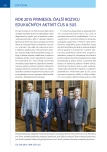-
Medical journals
- Career
PATIENTS’ RADIATION DOSES DURING PERCUTANEOUS NEPHROLITHOTOMY FOR URINARY STONES IN THE UROLOGICAL DEPARTMENT, ČESKÉ BUDĚJOVICE HOSPITAL
Authors: Pavel Tolinger 1; Aleš Petřík 1; Petr Berkovský 2
Authors‘ workplace: Urologické oddělení Nemocnice České Budějovice, a. s. 1; Onkologické oddělení Nemocnice České Budějovice, a. s. 2
Published in: Ces Urol 2015; 19(4): 291-295
Category: Original Articles
Overview
X-ray examinations are common in urological practice, especially in diagnosis and treatment of urinary stones. Although radiation doses of diagnostic methods are generally well known, only a few articles related to radiation doses during therapy have been published.
The aim of this work is to calculate radiation exposure, absorbed doses and dose rates of fluoroscopy during percutaneous nephrolitotomy (PNL).
In retrospective group of 250 patients who underwent PNL in our department from September 2011 to February 2015 we analyse data and calculate superficial air kerma and effective doses during surgery.
There are no statistically significant differences between single year data. Median fluoroscopy time was 214 seconds (range 2 to 750) with exposure of 89.5 mGy and effective dose 3.52mSv (range 0.04 to 13.2 mSv). The mean effective dose rate is 0.017 ± 0.0035 mSv per second.
Fluoroscopy is safe and we don´t exceed local dose limit references. Patients are exposed to an average 3.16 mSv during PNL, similar to noncontrast CT or intravenous urogram. Although radiation exposure for surgeon and operating theatre staff doesn´t exceed safe limits, urologists must be aware and decrease radiation exposure to as low as possible.KEY WORDS:
Percutaneous nephrolitotomy, urinary stones, radiation doses.
Sources
1. Murphy MJ, et al. The management of imaging dose during image-guided radiotherapy: Report of the AAPM Task Group 75. Med. Phys. 34, 404154061 (2007).
2. Nechvíl K, Mynařík J, Doležel M, Minaříková I. Odhad radiační zátěže pacientů ze zobrazovacích metod používaných při IGRT http://www.iaea.org/inis/collection/NCLCollectionStore/_Public/40/059/40059816.pdf
3. Michael E, Lipkin, Agnes J, et al. Determination of Patient Radiation Dose During Ureteroscopic Treatment
of Urolithiasis Using a Validated Model. The Journal of Urology Published Online: January 19, 2012.
4. Vyhláška Státního úřadu pro jadernou bezpečnost č. 307/2002 Sb. O radiační ochraně + Přílohy v novelizovaném znění platném od 1. 12. 2012.
5. Petřík A. Diagnostika a terapie urolitiázy. Urol. praxi, 2011; 12(3): 173–179.
6. Zöller G, Virsik-Köpp P, Vowinkel C. Patient radiation exposure during ureteroscopic stone extraction. Der Urologe. Ausg. A 2013, 52(1): 60–64.
7. EAU Guidelines 2015. http://www.europeanurology.com/article/S0302-2838(15)00699-5/abstract/eau -
guidelines-on-diagnosis-and-conservative-management-of-urolithiasis
8. Bushberg JT, et al. The Essential Physics of Medical Imaging, ISBN-13 : 978-0-683-30118-2, ISBN-10 : 0-683-30118-2.
Labels
Paediatric urologist Nephrology Urology
Article was published inCzech Urology

2015 Issue 4-
All articles in this issue
- INFECTED CYST CAUSING A MECHANICAL SYNDROME AS A COMPLICATION OF A RENAL CELL CARCINOMA
- LAPAROSCOPIC RESECTION OF LEIOMYOMA OF TRIGONE OF URINARY BLADDER
- TREATMENT OF LOCALIZED AND LOCALLY ADVANCED PROSTATE CANCER FROM A UROLOGIST‘S AND RADIATION ONCOLOGIST’S POINT OF VIEW.
- CELL CULTURE MODELS OF UROTHELIAL CARCINOMA CHEMORESISTANCE
- ESTABLISHMENT AND CHARACTERIZATION OF MULTIDRUG RESISTANT CELL LINE MODEL OF UROTHELIAL CARCINOMA
- PATIENTS’ RADIATION DOSES DURING PERCUTANEOUS NEPHROLITHOTOMY FOR URINARY STONES IN THE UROLOGICAL DEPARTMENT, ČESKÉ BUDĚJOVICE HOSPITAL
- SEVEN YEARS EXPERIENCES WITH APLICATION OF SHOCK WAVES TO MEN WITH PEYRONIE‘S DISEASE
- SYNCHRONOUS BILATERAL TESTICULAR SEMINOMA
- Czech Urology
- Journal archive
- Current issue
- Online only
- About the journal
Most read in this issue- SEVEN YEARS EXPERIENCES WITH APLICATION OF SHOCK WAVES TO MEN WITH PEYRONIE‘S DISEASE
- SYNCHRONOUS BILATERAL TESTICULAR SEMINOMA
- INFECTED CYST CAUSING A MECHANICAL SYNDROME AS A COMPLICATION OF A RENAL CELL CARCINOMA
- TREATMENT OF LOCALIZED AND LOCALLY ADVANCED PROSTATE CANCER FROM A UROLOGIST‘S AND RADIATION ONCOLOGIST’S POINT OF VIEW.
Login#ADS_BOTTOM_SCRIPTS#Forgotten passwordEnter the email address that you registered with. We will send you instructions on how to set a new password.
- Career

